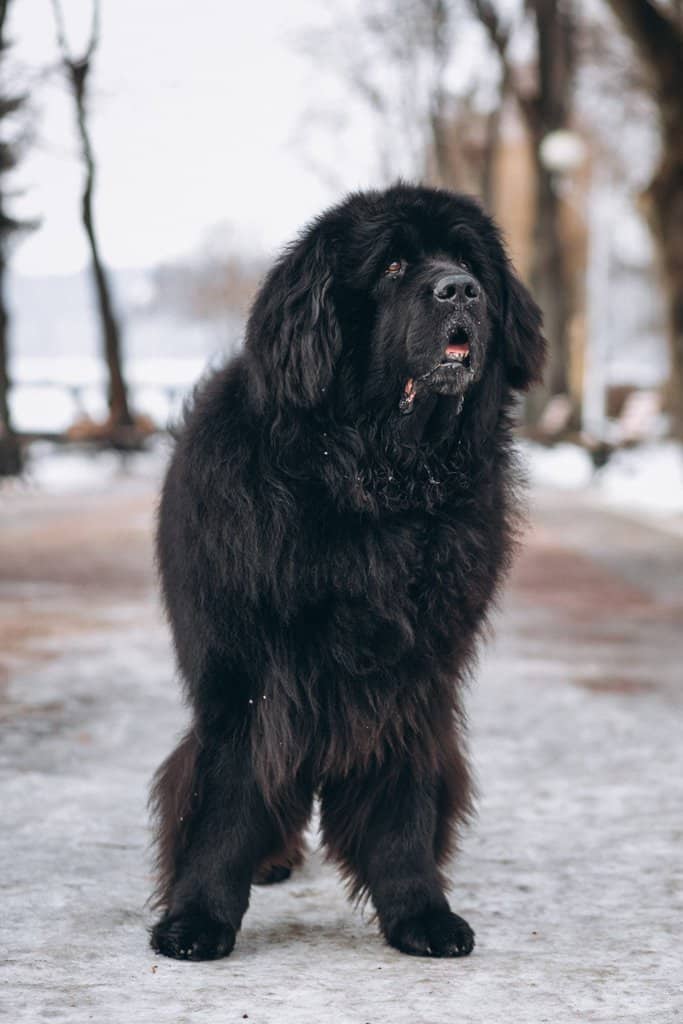Newfoundland dogs, also known as Newfies, are large, powerful dogs originally bred to work in the icy waters off the coast of Newfoundland, Canada. Their thick, water-resistant double coats provide insulation and protection from the cold, making them well-suited to colder weather conditions. However, they can also adapt to warmer weather with proper care and attention from their owners.

How do Newfoundland dogs fare in different weather conditions and what kind of precautions should owners take during extreme temperatures?
In cold weather, Newfoundland dogs are generally comfortable as long as they are kept dry and have access to shelter when needed. Their thick coats help them retain body heat, and they are able to regulate their body temperature to some extent by adjusting their posture and behavior. However, if their fur becomes wet, they may be at risk of hypothermia, which can be life-threatening. Owners should be vigilant about keeping their Newfoundland dog dry and warm, especially during wet or snowy weather.
In warmer weather, Newfoundlands can overheat easily, especially if they are exercising or spending time in direct sunlight. Their thick coats can trap heat and prevent air from circulating around their bodies, which can lead to heatstroke. Owners should provide plenty of shade, fresh water, and avoid exercising their dog during the hottest parts of the day. It’s also a good idea to trim their fur to a shorter length in the summer to help them stay cool. Owners should be aware that Newfoundlands are prone to heat exhaustion due to their size, so it is important to take extra precautions to prevent this.
It’s also important to remember that extreme temperatures, whether hot or cold, can be dangerous for all dogs, not just Newfoundlands. Owners should always monitor their dog closely for signs of distress, which can include panting, drooling, lethargy, vomiting, shivering, lethargy, and confusion. If you notice any of these symptoms, seek veterinary attention immediately.
In conclusion, Newfoundland dogs are generally well-suited to colder weather due to their thick double coats, but they can adapt to warmer weather with proper care and attention from their owners. Owners should be mindful of their dog’s comfort and safety, especially during extreme temperatures, and take precautions to prevent heat exhaustion or hypothermia. With proper care and attention, Newfoundlands can thrive in a variety of weather conditions.
What kind of precautions should owners take during extreme temperatures?
During extreme temperatures, whether hot or cold, it is important for owners of Newfoundland dogs to take extra precautions to ensure their dog’s safety and well-being. Here are some specific steps that owners can take:
Provide adequate shelter: During cold weather, make sure that your Newfoundland has access to a warm and dry shelter where they can rest and stay out of the elements. In hot weather, provide shade for your dog to rest in and make sure they have access to cool water.
Monitor your dog’s temperature: Take your dog’s temperature with a rectal thermometer to ensure that they are not becoming too hot or too cold. If their temperature is outside of the normal range (between 100.5 and 102.5 degrees Fahrenheit), take action to regulate their body temperature.
Limit exercise: During extreme temperatures, avoid exercising your Newfoundland during the hottest or coldest parts of the day. Stick to shorter walks or play sessions and monitor your dog’s behavior for signs of distress.
Hydration: Ensure that your Newfoundland has access to fresh water at all times. In hot weather, consider adding ice cubes to the water bowl to help keep the water cool. Encourage your dog to drink water regularly to prevent dehydration.
Cooling and Heating: In hot weather, provide your dog with ways to cool down, such as a cooling mat, a shaded area, or a wading pool. In cold weather, provide a heated bed or blankets, or use a dog-safe heating pad to help keep your dog warm.
Grooming: Regular grooming can help keep your dog’s coat clean and healthy, which can help regulate their body temperature. In hot weather, consider trimming your dog’s fur to a shorter length to help them stay cool.
Be aware of signs of distress: Monitor your Newfoundland closely for signs of distress, including excessive panting, drooling, lethargy, vomiting, shivering, lethargy, and confusion. If you notice any of these symptoms, seek veterinary attention immediately.
By taking these precautions, owners can help ensure that their Newfoundland stays safe and healthy during extreme temperatures.
If you liked this article (or if it helped at all), leave a comment below or share it with friends, so they can also know How do Newfoundland dogs fare in different weather conditions and what kind of precautions should owners take during extreme temperatures?




.jpg)

.jpg)
.jpg)